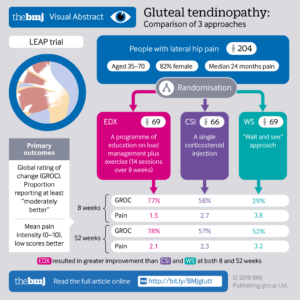by John A. Baur, PT, DPT, OCS, CSCS, FAAOMPT
Physical Therapist
Gluteal Tendinopathy – Hip Pain
Patients know it as hip pain, but the medical term is gluteal tendinopathy and this is often seen in conjunction with Trochanteric/Hip Bursitis. Gluteal tendinopathy can occur after performing an unaccustomed activity or after caring out a common activity for longer period than normal or under too much resistance. Gluteal tendinopathy arises when the gluteal tendons fails to heal completely. One in four women over the age of 50 have gluteal tendinopathy and 10-25% of the general population will experience this disorder. The hip pain and tenderness of gluteal tendinopathy interferes with sleep and daily physical activities. It is equivalent to severe hip osteoarthritis.
Treatments for Gluteal Tendinopathy
The traditional method for treating gluteal tendinopathy is with cortisone injections. A more contemporary approach is physical therapy combined with patient education. Another approach is to just wait it out.
Research to Determine the Most Effective Treatment
A recently published clinical trial in the British Medical Journal researchers compared the success of the following treatments for gluteal tendinopathy [https://www.bmj.com/content/361/bmj.k1662]:
- Cortisone Injection
- Physical therapy
- Wait and see
Researchers hypothesized that physical therapy and cortizone injection use would be better than a wait and see approach in the short term (after eight weeks), whereas physical therapy would be better than cortisone injection use in the longer term (after 52 weeks).
Participants
Individuals selected for the study met with following criteria:
- Aged 35-70 years
- Lateral hip pain for more than three months
- Pain at least a 4 out of 10 on the pain numerical rating scale
- Gluteal tendinopathy confirmed by clinical diagnosis and magnetic resonance imaging
- No cortisone injection use in previous 12 months
- No current physical therapy
- No total hip replacement
- No neurological conditions.
Results
All three groups; physical therapy, cortisone injection and wait and see, were different from each other in success rate. The success rate was determined by how well the patient said they had improved and their pain level.
At eight weeks the Physical Therapy Group had highest success rate
- Physical Therapy success rate was greater than Wait and See
- Cortisone Injection success rate was greater than Wait and See
- Physical Therapy success rate was greater than Cortisone Injection
At 52 Weeks Physical Therapy Success Group had the Highest Success Rate
- Physical Therapy success rate was greater than Cortisone Injection
- Physical Therapy success rate was greater than Wait and See
- Cortisone Injection success rate was equal to Wait and See
Conclusions
Physical therapy is the best treatment option for managing gluteal tendinopathy. Patients experience improvement in the short-term (at 8 weeks) and in the long-term (at 52 weeks) than they would with a cortisone injection or with a wait and see approach.
Physical Therapy First Approach
At Physical Therapy First each patient undergoes a complete examination to determine the underlying biomechanical cause of her/his hip bursitis / tendinopathy. Physical therapy can help hip bursitis / tendinopathy and it all starts with a thorough examine which will include assessing:
- muscle imbalances
- specific muscle weakness
- muscle flexibility
- joint mobility
- functional movement
- posture
- neurological exam
Based on the finding from the initial physical therapy assessment, a custom treatment plan will be designed to restore pain-free movement quickly and efficiently, and ultimately decrease the pain resulting from hip bursitis / tendinopathy.
Some of the treatments that may be provided in physical therapy to help recover from bursitis / tendinopathy includes:
- joint mobilization
- soft tissue mobilization
- specific muscle strengthening
- muscle stretching
- postural correction
- correction of biomechanical faults in functional movement
- home exercise program
- physical therapy modalities, such as, moist heat, cold packs, ultrasound, electrical stimulation, phototherapy/laser
Original article: Mellor Rebecca, Bennell Kim, Grimaldi Alison, Nicolson Philippa, Kasza Jessica, Hodges Paul et al. Education plus exercise versus corticosteroid injection use versus a wait and see approach on global outcome and pain from gluteal tendinopathy: prospective, single blinded, randomised clinical trial BMJ 2018; 361 :k1662 https://www.bmj.com/content/361/bmj.k1662

